#Paul Behrens
Text
Full Article Text:
The United Kingdom is facing dire food shortages, forcing prices to skyrocket, and experts predict this is only the beginning.
What's happening?
According to a report by The Guardian, extreme weather is wreaking havoc on crops across the region. England experienced more rainfall during the past 18 months than it has over any 18-month period since record-keeping began in 1836.
Because the rain hasn't stopped, many farmers have been unable to get crops such as potatoes, carrots, and wheat into the ground. "Usually, you get rain but there will be pockets of dry weather for two or three weeks at a time to do the planting. That simply hasn't happened," farmer Tom Allen-Stevens told The Guardian.
Farmers have also planted fewer potatoes, opting for less weather-dependent and financially secure crops. At the same time, many of the potatoes that have been planted are rotting in the ground.
"There is a concern that we won't ever have the volumes [of potatoes] we had in the past in the future," British Growers Association CEO Jack Ward told The Guardian. "We are not in a good position and it is 100% not sustainable," Ward added.
Why is it important?
English farmers aren't alone — people are struggling to grow crops worldwide because of extreme weather.
Dry weather in Brazil and heavy rain in Vietnam have farmers concerned about pepper production. Severe drought in Spain and record-breaking rain and snowfall in California have made it difficult for farmers to cultivate olives for olive oil. El Niño and rising temperatures cut Peru's blueberry yield in half last year. Everyone's favorite drinks — coffee, beer, and wine — have all been impacted by extreme weather.
According to an ABC News report, the strain on the agriculture industry will likely continue to cause food prices to soar.
If these were just isolated events, farmers could more easily adapt — bad growing seasons are nothing new. The problem is that rising temperatures are directly linked to the increasing amount of gases such as carbon dioxide and methane in the atmosphere.
Since the start of the Industrial Revolution, humans have burned dirty energy sources such as coal, oil, and gas, which release a significant amount of those gases. Our climate is changing so drastically that the 10 warmest years since 1850 have all occurred in the last decade.
"As climate change worsens, the threat to our food supply chains — both at home and overseas — will grow," Energy and Climate Intelligence Unit analyst Amber Sawyer told The Guardian.
What can we do about it?
"Fortunately, we know many ways we can make the food system more resilient while reducing food emissions. The biggest opportunity in high-income nations is a reduction in meat consumption and exploration of more plants in our diets," said Dr. Paul Behrens, an associate professor of environmental change at Leiden University in the Netherlands.
If we replace a quarter of our meat consumption with vegetables, we could cut around 100 million tons of air pollution yearly. It may seem strange to suggest eating more vegetables with the decline in crop production. However, reducing the land and water used for animal agriculture and diverting those resources to growing more produce would drastically help the declining food supply.
Growing our own food is also a great way to reduce our reliance on store-bought produce, and it can save you hundreds of dollars a year at the grocery store.
121 notes
·
View notes
Text
The EU, which plans to make Europe the first climate-neutral continent by 2050, spends nearly one-third of its entire budget on CAP subsidies. “The vast majority of that is going towards products which are driving us to the brink,” said Paul Behrens, an environmental change researcher at Leiden University and co-author of the study.
The subsidy scheme, which pays more to farms that occupy more land, results in “perverse outcomes for a food transition” because livestock take up more space than plants and are inefficiently fed crops that could have gone to people, the researchers found. To produce the same amount of protein, beef requires 20 times more land than nuts and 35 times more than grains.
103 notes
·
View notes
Text
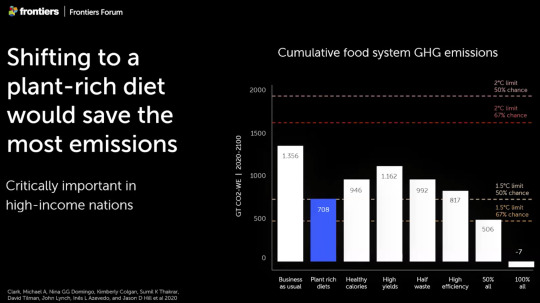
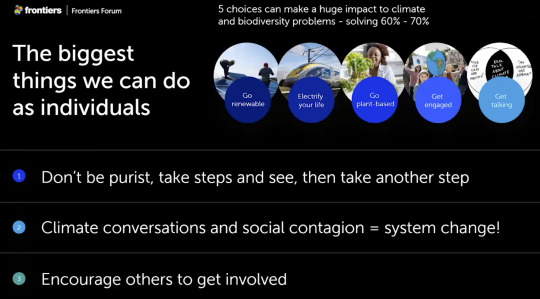
I just listened to this Frontiers forum which highlighted the current challenges to global climate change and strategies to combat them from behavioral, political, and psychological perspectives.
Some big takeaways for me:
we generally did a pretty good job of estimating the consequences of warming
some patterns (both good and bad) are moving more rapidly than expected
eating a plant-based diet is one of the most effective ways of cutting emissions
people care a lot more about climate change than we think they do
most of the burden is being borne by individuals who are contributing the least, and vice versa
climate scientists know that there will be push back from businesses and stakeholders. they are expecting it
climate anxiety is real and valid but doesn't need to cripple you. you have more agency and more sway than you think
In the spirit of spreading the message, here's some screenshots I found helpful and a link a book by Dr. Paul Behren's (the speaker) called The Best of Times, the Worst of Times, a message of pessimism and of hope.
7 notes
·
View notes
Text

Gemäß einer brandneuen Studie der Fachzeitschrift »Nature Food« fließen 82 Prozent der Agrarsubventionen der EU in die Produktion von Tierprodukten. Davon gehen 38 Prozent direkt in die Tierhaltung und 44 Prozent in die Futtermittelproduktion. ☹️
»Es ist besorgniserregend, dass die Agrarsubventionen, die die größten Ausgaben der EU darstellen, so stark tierische Produkte mit hohen Emissionen begünstigen und unseren Weg zu einem nachhaltigen Lebensmittelsystem behindern«, so Studienautor Paul Behrens.
Diese Zahlen seien nicht nur aus ökologischer Sicht bedenklich, auch der Nährwert stehe in keinem Verhältnis zu den Kosten, so die Autoren der Studie. Fleisch und tierische Produkte liefern nur 35 Prozent der in der EU verbrauchten Kalorien und nur 65 Prozent des Proteins. Gleichzeitig sind Tierfleisch, Käse, Kuhmilch und Co. aber für 84 Prozent der Treibhausgase in der Landwirtschaft verantwortlich.
Das Wissenschaftsteam kritisiert, dass wir mit unseren Steuern somit ein gesundheits- und klimaschädliches System unterstützen. Alle Getreide-, Gemüse- und Obstproduzenten der EU müssen sich die verbliebenen 18 Prozent der EU-Agrarsubventionen teilen.
Sie plädieren dafür, die EU-Subventionen für die Landwirtschaft endlich nach Umwelt- und Klimakriterien umzubauen, auch weil Bauern am Ende selbst von den Folgen des Klimawandels betroffen seien. »Eine pflanzenreichere Ernährung ist dringend erforderlich«, heißt es in dem Papier. Das wäre nicht nur klimafreundlicher, sondern würde auch zu mehr Ernährungssicherheit führen.
Diesen Forderungen schließen wir uns natürlich komplett an! 😎🌱
Quellen:
➡ LINK 1
➡ LINK 2
➡ LINK 3
➡ LINK 4
CHANGE IS COMING! 😊💚
#vegansforfuture#vegan#fridaysforfuture#landwirtschaft#ernährungswende#agrarwende#vegetarisch#klimakrise#klimaschutz#pflanzenfleisch
0 notes
Text

Wilhelm Schmid, 7 February 1892 Remigen - 1 December 1971, Brè sopra Lugano,
Swiss painter who is categorised as belonging to the New Objectivity and Magical Realism movements.
He moved to Berlin in 1912. He initially worked there with Peter Behrens. In 1913, he worked with Bruno Paul and in 1914 became studio manager in the Berlin office of architect Paul Renner.
In 1918, he co-founded the November Group, which brought together the "revolutionaries of the spirit" (artists such as Otto Dix, Wassily Kandinsky and Rudolf Belling belonged to it).
A monograph on his painting was published in 1923, in which his Pierrots lunaires or musician paintings such as Puccini Butterfly, the Mona Luna, early landscapes and individual still lifes were depicted. Wilhelm Schmid belonged to the New Objectivity artistic and cultural movement.
He moved to France in 1924. He returned to Berlin in 1930. Partly influenced by French surrealism, he painted pictures such as Le Duel and other Headless. His paintings were acquired by museums and private collectors.
In 1937, ten of his paintings were confiscated from the Städtische Gemäldegalerie Bochum, the Städtische Kunstsammlung Duisburg, the Museum Folkwang Essen, the Städtische Kunsthalle Mannheim, the Museum für Kunst und Kunstgewerbe Stettin and the Ruhmeshalle Wuppertal-Barmen as part of the Nazi "Degenerate Art" campaign. Seven of these were destroyed. The whereabouts of the others are unknown.
"Fuoco" (Fire), 1920
Three naked, gesticulating female figures with loamy skin and bodies like mannequins in nocturnal blue, behind them a man with a violin setting the pace. In 1937, the painting "Fuoco" (Fire) was declared "degenerate art" by the National Socialists. For Wilhelm Schmid this meant economic ruin.
1 note
·
View note
Text

Unraveling the WellCare Scandal: Unveiling Fraudulent Practices in the Health Insurance Industry
WellCare once stood as a prominent player in the intricate landscape of the United States health insurance industry. However, beneath its veneer of success, a scandal of monumental proportions was brewing. This industry giant's allegations, accusations, and revelations of fraudulent practices sent shockwaves through the healthcare sector. This article takes a comprehensive look at the WellCare scandal, delving into the intricate details of the scheme, the key players involved, the legal consequences they faced, and the broader implications for the industry.
The Birth of a Deceptive Scheme
In 2017, a fifth former executive from WellCare Health Plans was handed a six-month prison sentence for his involvement in a complex and audacious Medicaid fraud scheme. The roots of this scheme can be traced back to 2006, when top executives at WellCare, including a former general counsel, hatched a plan to manipulate investment figures within the company's annual reports. Their sinister objective was to artificially inflate the investments in behavioral health to reduce payback obligations and significantly enrich themselves in the process.
Thaddeus M.S. Bereday's Role: The Puppet Master
Thaddeus M.S. Bereday, a former executive and general counsel based in Tampa, Florida, was at the heart of this labyrinthine web of deceit. Bereday's role in the scheme was pivotal, as he admitted to submitting inflated expenditure details in the company's annual reports to the Florida Medicaid Program. These falsified figures were designed to minimize healthcare management organizations’ (HMOs) payback obligations concerning behavioral healthcare services. Bereday's admission highlighted the extent of manipulation within WellCare and underscored the depth of his involvement in orchestrating this fraudulent activity.
Violating Medicaid Premium Expenditure Requirement: A Breach of Trust
In 2002, Florida implemented a statute that mandated Medicaid HMOs to allocate at least 80 percent of the Medicaid premium towards specific behavioral health services for beneficiaries. Any deviation from this requirement would necessitate returning excess funds to the Medicaid Program. The fraudulent actions of WellCare's executives in artificially inflating investment figures directly violated this statute. This breach of trust demonstrated their outright disregard for ethical and legal standards, underlining the extent to which greed can drive corporate misconduct.
The Legal Fallout: Justice Served
The legal repercussions for the perpetrators of this fraudulent scheme were significant. Bereday and his fellow executives found themselves at the center of an indictment that exposed their calculated efforts to submit inflated payment information within the company's annual reports. This manipulation aimed to evade the contractual payback responsibilities associated with behavioral health care services. In 2013, a jury found them guilty, subsequently upheld by a federal appellate court in 2016. These verdicts marked a notable step toward holding corporate leaders accountable for fraudulent activities.
Sentences That Reflect the Severity
The severity of the charges levied against the key players in the scheme was mirrored in the sentences they received:
Peter E. Clay, formerly the vice president of medical economics, received a sentence of five years probation for making false statements to a law enforcement officer.
Todd S. Farha, the former CEO of WellCare, was convicted on two counts of healthcare fraud and was sentenced to three years in prison.
William L. Kale, a former vice president of Harmony Behavioral Health Inc. (a subsidiary of WellCare), was found guilty of healthcare fraud and received a sentence of one year and one day in prison.
Paul L. Behrens, the former CFO of WellCare, faced a two-year prison sentence after being convicted on two counts of making false statements relating to healthcare matters and two counts of healthcare fraud.
Monetary Consequences and the Path Forward
In 2009, WellCare was ordered to pay a hefty sum of $40 million in restitution and forfeit an additional $40 million, all while cooperating with the government's criminal investigation. Surprisingly, the company met all the requirements, resulting in the dismissal of the criminal information. This outcome raised pertinent questions about the effectiveness of punitive measures in deterring corporate misconduct.
Implications for the Broader Industry
The WellCare scandal resonated far beyond the confines of a single company. It exposed the vulnerabilities within the health insurance industry, illustrating how fraudulent activities can flourish when left unchecked. This case emphasized the critical need for stricter regulatory oversight, the cultivation of ethical corporate leadership, and the demand for transparent financial reporting within the industry.
Furthermore, establishing the Medicare Fraud Strike Force in 2007 signaled a collective commitment to combating fraud and safeguarding the integrity of healthcare programs. This initiative, currently operational in nine cities across the country, underscores the collaborative effort to tackle fraudulent activities that jeopardize the accessibility and quality of healthcare for countless individuals.
The Prodigal Lesson
In conclusion, the WellCare scandal serves as an enduring testament to the depths of deception to which corporate executives can sink, all in pursuit of personal gain. This saga of fraudulent practices exposed a disconcerting lack of ethical conduct and a blatant disregard for legal boundaries. The legal actions taken against the individuals involved in this scheme reaffirm society's determination to hold accountable those who exploit the healthcare system for personal enrichment.
As the health insurance industry continues to evolve, the lessons from the WellCare scandal must serve as a guiding light for policies and practices. These lessons extend far beyond the confines of a single corporation, acting as a reminder of the inherent responsibility of corporate leaders and regulatory bodies to safeguard the interests of beneficiaries and the integrity of the industry at large. As we reflect on this dark chapter, the hope is that the sector emerges more robust, more transparent, and more vigilant against the allure of fraudulent activities.
0 notes
Text

Unraveling the WellCare Scandal: Unveiling Fraudulent Practices in the Health Insurance Industry
WellCare once stood as a prominent player in the intricate landscape of the United States health insurance industry. However, beneath its veneer of success, a scandal of monumental proportions was brewing. This industry giant's allegations, accusations, and revelations of fraudulent practices sent shockwaves through the healthcare sector. This article takes a comprehensive look at the WellCare scandal, delving into the intricate details of the scheme, the key players involved, the legal consequences they faced, and the broader implications for the industry.
The Birth of a Deceptive Scheme
In 2017, a fifth former executive from WellCare Health Plans was handed a six-month prison sentence for his involvement in a complex and audacious Medicaid fraud scheme. The roots of this scheme can be traced back to 2006, when top executives at WellCare, including a former general counsel, hatched a plan to manipulate investment figures within the company's annual reports. Their sinister objective was to artificially inflate the investments in behavioral health to reduce payback obligations and significantly enrich themselves in the process.
Thaddeus M.S. Bereday's Role: The Puppet Master
Thaddeus M.S. Bereday, a former executive and general counsel based in Tampa, Florida, was at the heart of this labyrinthine web of deceit. Bereday's role in the scheme was pivotal, as he admitted to submitting inflated expenditure details in the company's annual reports to the Florida Medicaid Program. These falsified figures were designed to minimize healthcare management organizations’ (HMOs) payback obligations concerning behavioral healthcare services. Bereday's admission highlighted the extent of manipulation within WellCare and underscored the depth of his involvement in orchestrating this fraudulent activity.
Violating Medicaid Premium Expenditure Requirement: A Breach of Trust
In 2002, Florida implemented a statute that mandated Medicaid HMOs to allocate at least 80 percent of the Medicaid premium towards specific behavioral health services for beneficiaries. Any deviation from this requirement would necessitate returning excess funds to the Medicaid Program. The fraudulent actions of WellCare's executives in artificially inflating investment figures directly violated this statute. This breach of trust demonstrated their outright disregard for ethical and legal standards, underlining the extent to which greed can drive corporate misconduct.
The Legal Fallout: Justice Served
The legal repercussions for the perpetrators of this fraudulent scheme were significant. Bereday and his fellow executives found themselves at the center of an indictment that exposed their calculated efforts to submit inflated payment information within the company's annual reports. This manipulation aimed to evade the contractual payback responsibilities associated with behavioral health care services. In 2013, a jury found them guilty, subsequently upheld by a federal appellate court in 2016. These verdicts marked a notable step toward holding corporate leaders accountable for fraudulent activities.
Sentences That Reflect the Severity
The severity of the charges levied against the key players in the scheme was mirrored in the sentences they received:
Peter E. Clay, formerly the vice president of medical economics, received a sentence of five years probation for making false statements to a law enforcement officer.
Todd S. Farha, the former CEO of WellCare, was convicted on two counts of healthcare fraud and was sentenced to three years in prison.
William L. Kale, a former vice president of Harmony Behavioral Health Inc. (a subsidiary of WellCare), was found guilty of healthcare fraud and received a sentence of one year and one day in prison.
Paul L. Behrens, the former CFO of WellCare, faced a two-year prison sentence after being convicted on two counts of making false statements relating to healthcare matters and two counts of healthcare fraud.
Monetary Consequences and the Path Forward
In 2009, WellCare was ordered to pay a hefty sum of $40 million in restitution and forfeit an additional $40 million, all while cooperating with the government's criminal investigation. Surprisingly, the company met all the requirements, resulting in the dismissal of the criminal information. This outcome raised pertinent questions about the effectiveness of punitive measures in deterring corporate misconduct.
Implications for the Broader Industry
The WellCare scandal resonated far beyond the confines of a single company. It exposed the vulnerabilities within the health insurance industry, illustrating how fraudulent activities can flourish when left unchecked. This case emphasized the critical need for stricter regulatory oversight, the cultivation of ethical corporate leadership, and the demand for transparent financial reporting within the industry.
Furthermore, establishing the Medicare Fraud Strike Force in 2007 signaled a collective commitment to combating fraud and safeguarding the integrity of healthcare programs. This initiative, currently operational in nine cities across the country, underscores the collaborative effort to tackle fraudulent activities that jeopardize the accessibility and quality of healthcare for countless individuals.
The Prodigal Lesson
In conclusion, the WellCare scandal serves as an enduring testament to the depths of deception to which corporate executives can sink, all in pursuit of personal gain. This saga of fraudulent practices exposed a disconcerting lack of ethical conduct and a blatant disregard for legal boundaries. The legal actions taken against the individuals involved in this scheme reaffirm society's determination to hold accountable those who exploit the healthcare system for personal enrichment.
As the health insurance industry continues to evolve, the lessons from the WellCare scandal must serve as a guiding light for policies and practices. These lessons extend far beyond the confines of a single corporation, acting as a reminder of the inherent responsibility of corporate leaders and regulatory bodies to safeguard the interests of beneficiaries and the integrity of the industry at large. As we reflect on this dark chapter, the hope is that the sector emerges more robust, more transparent, and more vigilant against the allure of fraudulent activities.
0 notes
Text

Unraveling the WellCare Scandal: Unveiling Fraudulent Practices in the Health Insurance Industry
WellCare once stood as a prominent player in the intricate landscape of the United States health insurance industry. However, beneath its veneer of success, a scandal of monumental proportions was brewing. This industry giant's allegations, accusations, and revelations of fraudulent practices sent shockwaves through the healthcare sector. This article takes a comprehensive look at the WellCare scandal, delving into the intricate details of the scheme, the key players involved, the legal consequences they faced, and the broader implications for the industry.
The Birth of a Deceptive Scheme
In 2017, a fifth former executive from WellCare Health Plans was handed a six-month prison sentence for his involvement in a complex and audacious Medicaid fraud scheme. The roots of this scheme can be traced back to 2006, when top executives at WellCare, including a former general counsel, hatched a plan to manipulate investment figures within the company's annual reports. Their sinister objective was to artificially inflate the investments in behavioral health to reduce payback obligations and significantly enrich themselves in the process.
Thaddeus M.S. Bereday's Role: The Puppet Master
Thaddeus M.S. Bereday, a former executive and general counsel based in Tampa, Florida, was at the heart of this labyrinthine web of deceit. Bereday's role in the scheme was pivotal, as he admitted to submitting inflated expenditure details in the company's annual reports to the Florida Medicaid Program. These falsified figures were designed to minimize healthcare management organizations’ (HMOs) payback obligations concerning behavioral healthcare services. Bereday's admission highlighted the extent of manipulation within WellCare and underscored the depth of his involvement in orchestrating this fraudulent activity.
Violating Medicaid Premium Expenditure Requirement: A Breach of Trust
In 2002, Florida implemented a statute that mandated Medicaid HMOs to allocate at least 80 percent of the Medicaid premium towards specific behavioral health services for beneficiaries. Any deviation from this requirement would necessitate returning excess funds to the Medicaid Program. The fraudulent actions of WellCare's executives in artificially inflating investment figures directly violated this statute. This breach of trust demonstrated their outright disregard for ethical and legal standards, underlining the extent to which greed can drive corporate misconduct.
The Legal Fallout: Justice Served
The legal repercussions for the perpetrators of this fraudulent scheme were significant. Bereday and his fellow executives found themselves at the center of an indictment that exposed their calculated efforts to submit inflated payment information within the company's annual reports. This manipulation aimed to evade the contractual payback responsibilities associated with behavioral health care services. In 2013, a jury found them guilty, subsequently upheld by a federal appellate court in 2016. These verdicts marked a notable step toward holding corporate leaders accountable for fraudulent activities.
Sentences That Reflect the Severity
The severity of the charges levied against the key players in the scheme was mirrored in the sentences they received:
Peter E. Clay, formerly the vice president of medical economics, received a sentence of five years probation for making false statements to a law enforcement officer.
Todd S. Farha, the former CEO of WellCare, was convicted on two counts of healthcare fraud and was sentenced to three years in prison.
William L. Kale, a former vice president of Harmony Behavioral Health Inc. (a subsidiary of WellCare), was found guilty of healthcare fraud and received a sentence of one year and one day in prison.
Paul L. Behrens, the former CFO of WellCare, faced a two-year prison sentence after being convicted on two counts of making false statements relating to healthcare matters and two counts of healthcare fraud.
Monetary Consequences and the Path Forward
In 2009, WellCare was ordered to pay a hefty sum of $40 million in restitution and forfeit an additional $40 million, all while cooperating with the government's criminal investigation. Surprisingly, the company met all the requirements, resulting in the dismissal of the criminal information. This outcome raised pertinent questions about the effectiveness of punitive measures in deterring corporate misconduct.
Implications for the Broader Industry
The WellCare scandal resonated far beyond the confines of a single company. It exposed the vulnerabilities within the health insurance industry, illustrating how fraudulent activities can flourish when left unchecked. This case emphasized the critical need for stricter regulatory oversight, the cultivation of ethical corporate leadership, and the demand for transparent financial reporting within the industry.
Furthermore, establishing the Medicare Fraud Strike Force in 2007 signaled a collective commitment to combating fraud and safeguarding the integrity of healthcare programs. This initiative, currently operational in nine cities across the country, underscores the collaborative effort to tackle fraudulent activities that jeopardize the accessibility and quality of healthcare for countless individuals.
The Prodigal Lesson
In conclusion, the WellCare scandal serves as an enduring testament to the depths of deception to which corporate executives can sink, all in pursuit of personal gain. This saga of fraudulent practices exposed a disconcerting lack of ethical conduct and a blatant disregard for legal boundaries. The legal actions taken against the individuals involved in this scheme reaffirm society's determination to hold accountable those who exploit the healthcare system for personal enrichment.
As the health insurance industry continues to evolve, the lessons from the WellCare scandal must serve as a guiding light for policies and practices. These lessons extend far beyond the confines of a single corporation, acting as a reminder of the inherent responsibility of corporate leaders and regulatory bodies to safeguard the interests of beneficiaries and the integrity of the industry at large. As we reflect on this dark chapter, the hope is that the sector emerges more robust, more transparent, and more vigilant against the allure of fraudulent activities.
0 notes
Text
Raku, storia e tradizione dall'Oriente
La raku è una tecnica di ceramica giapponese tradizionale che prevede un rapido riscaldamento e raffreddamento del pezzo ceramico per creare una superficie e una texture uniche. È caratterizzata dai suoi colori terrosi, dalle venature increspate e dall'aspetto spontaneo. È spesso utilizzata per le cerimonie del tè e per altri scopi decorativi.
Storia della raku
Le origini risalgono alla fine del XVI secolo, durante il periodo Momoyama della storia giapponese. La tecnica fu sviluppata da Chōjirō, un vasaio di Kyoto, che fu incaricato di creare tazze da tè per Sen Rikyū, un rinomato maestro del tè. Rikyū apprezzò l'estetica rustica e non raffinata della raku, che credeva rispecchiasse i principi del buddismo zen.
Caratteristiche principali
- Cottura rapida: viene cotta a una temperatura relativamente bassa, tipicamente intorno ai 1.000 gradi Celsius. Questo processo di cottura rapido aiuta a creare la caratteristica venatura increspata e la superficie porosa.
- Riduzione di ossigeno: viene spesso cotta in un'atmosfera riducente, il che significa che c'è meno ossigeno presente durante il processo di cottura. Questa atmosfera ridotta favorisce la formazione di ossido di ferro, che conferisce il suo colore rosso-bruno.
- Immersione in cenere o segatura: Dopo la cottura, viene tipicamente immersa in un contenitore di cenere o segatura. Questa immersione provoca la crepatura della venatura e lo sviluppo di una finitura opaca sulla ceramica.
- Imperfezioni e spontaneità: è nota per le sue imperfezioni e irregolarità. Queste imperfezioni non sono considerate difetti, ma piuttosto una riflessione della natura unica della tecnica.
Usi della raku
La raku è tradizionalmente utilizzata nelle cerimonie del tè giapponesi. La chawan, o tazza da tè, è la forma più comune utilizzata nelle cerimonie del tè. Le tazze da tè sono apprezzate per la loro capacità di esaltare il sapore e l'aroma del tè.
La raku viene utilizzata anche per una varietà di scopi decorativi. Le ciotole, i vasi e le sculture vengono spesso esposte in case e aziende. La raku viene utilizzata anche in alcune installazioni artistiche contemporanee.
In Occidente
La raku è stata introdotta in Occidente alla fine degli anni '50 da vasai americani come Paul Soldner e Mary Black. Questi vasai erano affascinati soprattutto dall'estetica unica e dal suo legame con la filosofia zen. Sperimentarono diverse tecniche e svilupparono i propri stili distintivi .
La raku è diventata sempre più popolare in Occidente e oggi è praticata da vasai di tutti i livelli di esperienza. I corsi vengono offerti in molti centri artistici comunitari e studi di ceramica.
Se sei interessato a saperne ancora di più, consulta le seguenti risorse:
- The Raku Handbook: Questo libro di Mary Black è una guida completa alla raku, che copre tutto, dalla storia e filosofia fino alle tecniche e materiali utilizzati.
- The Raku Compendium: Questo libro di Paul Soldner è un'altra eccellente risorsa per imparare a conoscerla. Include una vasta gamma di informazioni su diverse tecniche, venature e metodi di cottura.
- Raku: An Exploration of Form and Spirit: Questa raccolta di saggi e fotografie di Peter Behrens esplora la relazione tra la raku e la filosofia zen.
Foto di kimura2 da Pixabay
Read the full article
0 notes
Text

* INCOMING REQUEST : + 1 new wanted connection has been added — jack behrens ( olivia cooke ) is looking for her foster brother. find more at the source + under the read more !

attention, bighorns ! our prestigious community member JACK BEHRENS ( yes, the one that looks an awful lot like olivia cooke ) is looking for her FOSTER BROTHER. we’ve heard the wanted one is 30 to 35 years old and looks a lot like dev patel, josh hutcherson, apo nattawin, peter gadiot, oliver jackson-cohen, lewis tan, danny ramirez, kofi siriboe, taylor zakhar - perez, paul mescal, mena massoud, manny jacinto, alex meraz, drew starkey, kiowa gordon, utp ( seriously utp, these names are just suggestions in case you don’t know who to apply with or are indecisive ! ). the bulletin indicates you DON’T HAVE to ( but definitely can ! ) contact the mun at @slavghters to fill this search. we’ll be on full alert, the outcome of this quest may be highly beneficial for our sanctuary !
ADDITIONAL INFORMATION.
in very few words, this person is jack’s rock, her fiercest protector. but she is also his. they met at st. clare orphanage when jack was barely four and he arrived there ( the reasons for this and his whole backstory are totally utp, the only headcanon i have about his bg is that he saw a lot before arriving at the orphanage so he was a very sulking, prone to violence kid ). she felt an instant pull toward him, was always nagging him since she found him oh, so very cool ( we can discuss why ) and wanted him to be her friend — because that’s jack. however, he was constantly annoyed by her, she had too much energy, was too chatty, too oblivious, but she hardly realized how much of a nuisance she was to him. i headcanon it took him around a year to soften ( or for her to win him over ), but since then, since that shift in their relationship, keeping her safe and teaching her how to survive in this world, a world he knew very well what was capable of, became his priorities. once jack was old enough ( around her twelves ), those priorities became mutual. they have survived everything together, since before the outbreak, so when it hit they barely blinked. both of them are the kind of people who thrive in this reality because all they’ve been doing is what everyone has to do now: stay safe, stay alive.
extra: jack’s last name was given to her by the nun who took her under her wing and, well, basically raised her. they can or cannot share it, that’s utp !
#wanted connections.#appless rp#oc rp#mumu rp#new rp#me posting my own wanted connection ? more likely than u thenk !
0 notes
Text
INICIOS
La compañía Beiersdorf fue fundada en 1882 por el farmacéutico Paul Beiersdorf en Hamburgo. A partir de 1890, el empresario y farmacéutico Oscar Troplowitz compra la compañía y comienza a realizar una serie de procesos transformadores en la empresa, ampliándola y estableciendo sus primeras conexiones con contactos y mercados internacionales. Para Beiesdorf no era importante la publicidad sino el voz a voz y la venta derivada de estas teniendo en cuenta la calidad de sus productos. Es por este motivo que Troplowitz decide establecer como objetivo la venta por publicidad. Entre finales del siglo XIX y principios del XX, Troplowitz organizó a las principales cabezas de la empresa: Hermann Hansen, comerciante de confianza, Thaddaus Smielowski, farmacéutico que había trabajado con Beiesdorf, Paul Blessin, Christoph Behrens y el farmacéutico Maz Ohm, quien sería el manager de producción. Con este equipo, comenzaron a desarrollar ideas de publicidad visualmente atrayente. Esta estrategia de producción y mercadeo se enfocó en la creciente población en las ciudades alemanas. Para este entonces había un gran número de personas migrando de zonas rurales a zonas urbanas por lo que la población en Hamburgo aumentó desde 300.000 personas en 1871 a 570.000 en 1890 y para 1913 alcanzó alrededor de 6 millones de personas. Reckendrees, Alfred, 2018,. p.20).

Lo anterior indicó, para Troplowitz, la oportunidad de contratar más trabajadores y sobre todo de aumentar sus ingresos debido a la emergente clase media y alta que aparecía en Hamburgo. Este sería el público objetivo de los productos de Beiersdorf.
Es en esta época, alrededor de 1911, se creó la crema Nivea (que proviene de las palabras en latin “nix” o “nivis” que significa “nieve”). Esta crema, además, se diferenciaba de otras por tener siempre la misma fragancia característica, es decir, “no existían otras cremas para la piel que se pudieran encontrar en todas las farmacias o droguerías y que tuvieran siempre la misma fragancia” (Ibid.). Inicialmente se vendió a lo que eran precios elevados para la época y comprados por una “clientela de lujo”” (Reckendrees, A., 2018, p.21)
0 notes
Text
Sheraldo Becker met Union Berlin in de slotseconden ten onder in Madrid

Surinaams international Sheraldo Becker is met Union Berlin in de slotseconden ten onder gegaan woensdagmiddag in de Champions League tegen de machtige Real Madrid. De Koninklijken domineerden tegen FC Union Berlin, maar moesten tot het laatste minuut wachten op redder Jude Bellingham. Het werd 1-0.
De Surinaamse aanvaller was in de aanloop naar dit duel geblesseerd en was een twijfelgeval, maar hij herstelde op tijd en stond in het basiselftal. Hij vormde een aanvalsduo met Kevin Behrens. Real Madrid nam direct het heft in handen, maar had aanvankelijk moeite met het verdedigend ingestelde Union. De Duitse ploeg kwam zelfs tot de eerste kans van de wedstrijd. Real had moeite met de manier waarop Union terugzakte en dat leidde in de eerste helft ook tot enkele counterkansen van de bezoekers. De twee ploegen gingen met de brilstand aan de pauze.
In het tweede bedrijf was het weer Union dat een grote kans kreeg via Robin Goossens, maar uiteindelijk begon de Madrileense voetbalmachine steeds beter te draaien. Rodrygo Goes schoot hard op doelman Frederik Ronnow en trof daarna de paal. Even later klopte Joselu eveneens tegen het houtwerk. Union was enkele keren gevaarlijk via de counter, maar kon in de tweede helft minder brengen. Het Bernabeu schreeuwde een kwartier voor tijd om een strafschop na een vermeende handsbal van Danilho Doekhi, maar de arbiter wuifde het appel weg.
In de 81ste minuut werd Becker gewisseld en op zijn plek kwam Paul Jaeckel. Met deze wissel probeerde de coach van Union Berlin wat meer aanvallend te spelen. Desondanks beelf Real ook in de slotfase op zoek naar de openingstreffer, maar kansen van Joselu en Rodrygo werden niet omgezet in een doelpunt. In de slotminuut lukte het de thuisploeg alsnog: Federico Valverde loste een schot en niemand minder dan Bellingham kon de rebound vrij binnentikken.
In de volgende wedstrijd krijgen Sheraldo Becker en zijn club bezoek van Braga, terwijl Real Madrid op bezoek gaat naar Napoli.
Read the full article
0 notes
Text
CASA TUGENDHAT

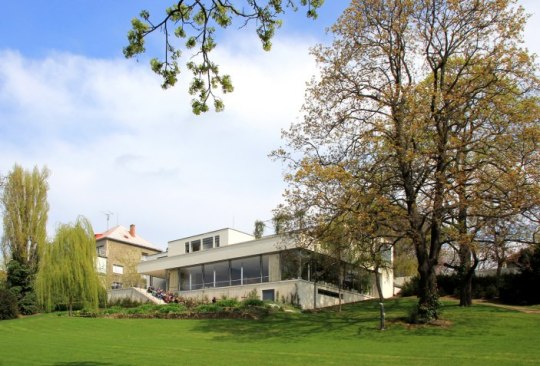







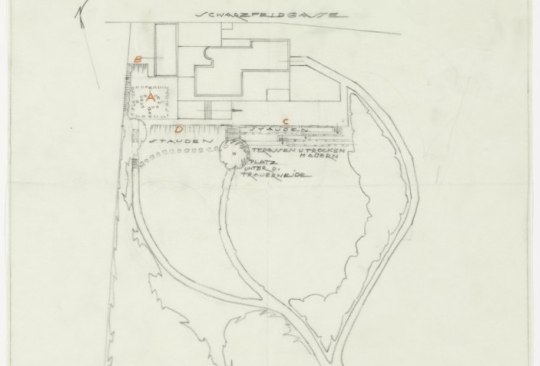


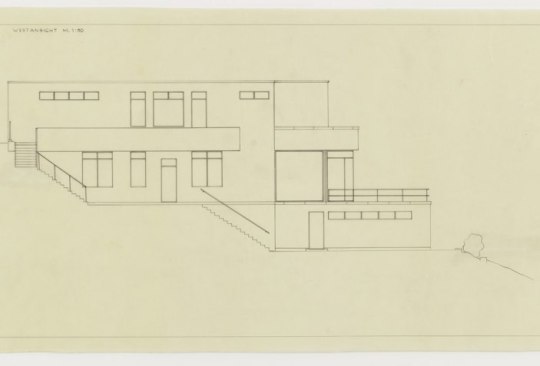
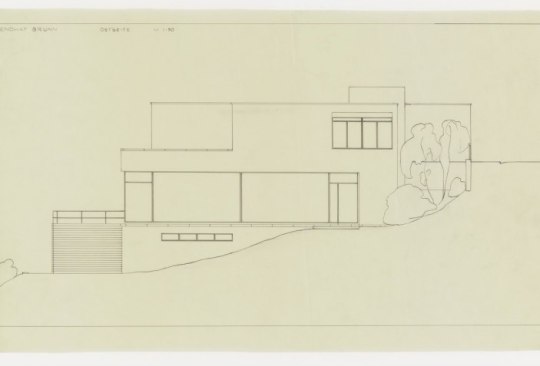
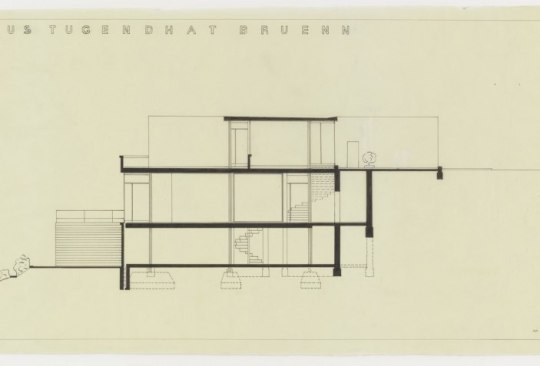

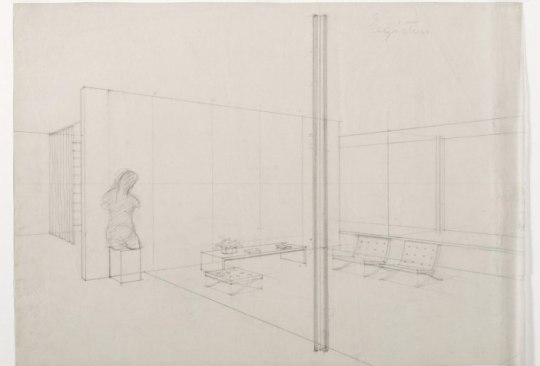
ARQUITECTO: MIES VAN DER ROHE
LOCALIZACIÓN: BRNO, REPÚBLICA CHECA
CRONOLOGÍA:
COMIENZO: 1928
FIN DE LA CONSTRUCCIÓN: 1930
BIOGRAFÍA
Ludwig Mies van der Rohe (Aquisgrán, Alemania, 1886 - Chicago, 1969), es un arquitecto alemán. Comenzó a trabajar con su padre en 1900 y en 1905 se mudó a Berlín para colaborar con Bruno Paul. De 1908 a 1911, trabajó en el Peter Behrens, donde conoció a Walter Gropius y Le Corbusier. Al principio trabajaba sobre todo arquitectura neoclásica, pero un viaje a los Países Bajos hizo que esto cambiase, redirigiendo su arquitectura hacia las vanguardias, un ejemplo de esto es el edificio de oficinas de la Friedrichstrasse de Berlín. Durante este período publicó la revista G, y se relacionó Tristan Tzara o El Lissitzky. A partir de 1926 comenzó a realizar obras de gran importancia como, la casa Wolf. Realizó el pabellón de Alemania para la Exposición Internacional de Barcelona en 1929 (una de las obras más influyentes del siglo XX).
Sus obras comienzan a caracterizarse por un uso avanzado de los nuevos materiales de construcción (cemento armado, acero y vidrio) y por una gran simplicidad, que lleva a dejar las estructuras a simple vista.
Tras dirigir la Bauhaus de 1930 a 1933, y su emigración a Estados Unidos, fue nombrado director de la facultad de arquitectura del Illinois Technology Institute de Chicago (1938).
Su carrera finalizó en 1958-1959 con el Seagram Building de Nueva York.
CONTEXTO
Cuando Mies Van der Rohe estaba diseñando el proyecto para la Exposición Universal de Barcelona sobre 1928, el arquitecto recibió un encargo de una pareja. El proyecto sería una mansión en Brno, Moravia que sería el regalo de boda de los padres de la pareja.
Por aquellos años, Moravia era considerado como pleno de centro de arquitectura moderna.
La familia, dio carta blanca a Mies tanto para la construcción como para el diseño del interior, siendo la casa un reflejo de todas las ideas arquitectónicas del arquitecto.
La mansión fue Habitada por la familia durante unos años, concretamente, hasta 1938 y en 1939 fue confiscada por los nacionalistas siendo cedida en 1942 al Reich. Durante la guerra, en la casa se ubica la fábrica de aviaciones Ostmark, pero en 1945 la armada roja se apropió de la casa hasta 1963 que fue declarada monumento cultural; además en 2001 fue declarada patrimonio universal de la Unesco. Cuando la casa comenzó a ser un monumento cultural esta se reformó, llevándose a cabo en el interior, en la parte de las instalaciones y el jardín
En cuanto al terreno, la casa se encuentra situada en una pendiente escarpada, con vistas hacia el casco antiguo. Además, era parte del jardín de Löw Beer.
CONCEPTO Y ESPACIO
Mies utilizó principio de «planta libre», para ello utiliza soportes cruciformes y pantallas de ónix hasta el techo que se distribuían por toda la mansión., separando las distintas zonas.
La zona principal era plurifuncional, se abría a la parte del desnivel con unas cristaleras, haciendo que el espacio interior y el paisaje se conformen como una unidad. A través de la puerta situada detrás de la zona-comedor, se llega a una terraza exterior, a la que también se puede acceder con unas escaleras que encontramos en el jardín.
La casa cuenta con 3 plantas. En la encontramos el sótano, al que se puede acceder desde el interior de la casa a través de una escalera de espiral (situada en la cocina) y dos accesos desde el exterior. En el sótano encontramos las zonas de mantenimiento y un laboratorio para fotos. En la segunda planta de la Casa (Planta Baja) a la que se accede desde una escalera ubicada en la entrada, también es accesible desde la fachada; en esta planta encontramos una zona de estar, el área social con un jardín de invierno, una sala de invitados con una biblioteca y un pequeño comedor.
La segunda parte de la planta está compuesta por la cocina con un cuarto para la preparación de la comida, y cuartos para los trabajadores de mansión. La tercera planta cuenta con una entrada situada en la pared semicircular de vidrio, es el hall de los invitados y un corredor que dirige a la habitación de los niños, baño y lavadero. La habitación principal y el baño se abren hacia el jardín, al lado de estos, encontramos un vestidor.
MOBILIARIO
Mies diseñó para esta casa numerosas piezas, como por ejemplo, la famosa silla Brno. Generalmente el diseño interior destacaba por la colación de muebles sobre alfombras blancas y grises.
MATERIALES Y ESTRUCTURA
El edificio está protegido por una pared maciza, debido al terraplén del terreno. El esqueleto en un armazón de acero, paños de vidrio, las barandas, puertas y ventanas y la escalera del sótano se materializaron en acero inoxidable. Los suelos están cubiertos de Baldosas de colores y las escaleras exteriores revestidas de travertino de colores. Y El área principal y el área social están divididos por tabiques de ónix amarillo-miel. En cuanto a la estructura está formada por pequeños pilares metálicos
BIBLIOGRAFÍA:
Wiki Arquitectura. Casa Tugendhat. Consultado el 16 Dic 2022
Urbipedia. Villa Tugendhat. Consultado el 16 Dic 2022
07/10/2016.Metalocus.BRNO República Checa. José Juan Barba/Branl y Ernesto Pérez
Biografías y vida La enciclopedia biográfica en línea. Ludwing Mies van der Rohe. Consultado el 22 Dic 2022
1 note
·
View note
Text
Bundesliga 22/23 - 1.FC Union Berlin
Frederik Ronnow und seine Freundin Sarah

Jakob Busk und seine Frau Celina

Lennart Grill und seine Freundin (ohne Bild)
Paul Jaeckel
Diogo Leite
Danilho Doekhi und seine Freundin (?)
Josip Juranovic und seine Verlobte Lana
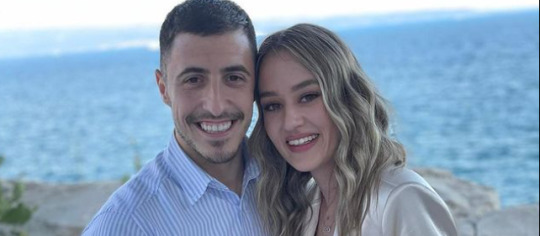
Niko Gießelmann und seine Frau Lana
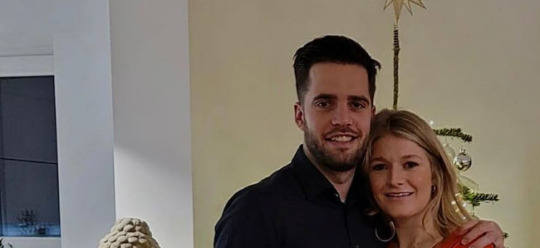
Timo Baumgartl und seine Freundin Julia

Jerome Roussillon
Christopher Trimmel und seine Frau Arnela
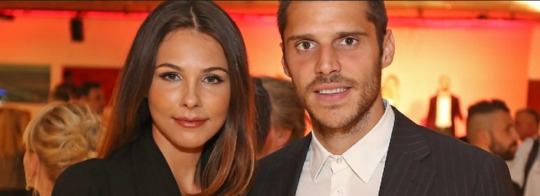
Robin Knoche und seine Frau Anna-Lena

Morten Thorsby
Levin Öztunali und seine Freundin Natasha

Rani Khedira und seine Freundin Amelia

Andras Schäfer und seine Freundin (ohne Bild)
Paul Seguin und seine Freundin Victoria

Janik Haberer und seine Frau Lorella

Aissa Laidouni
Kevin Möhwald und seine Verlobte Olivia

Milos Pantovic
Sven Michel und seine Frau Rebecca
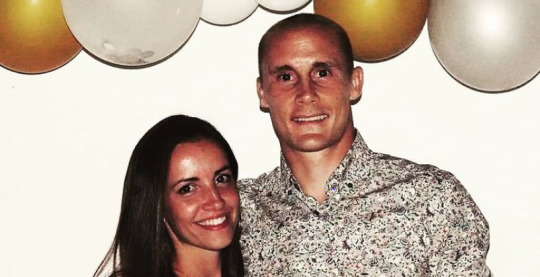
Tim Maciejewski
Kevin Behrens und seine Partnerin (ohne Bild)
Sheraldo Becker und seine Partnerin Kelly

Jamie Leweling
Jordan Siebatcheu
0 notes
Text
Get now Type: A Visual History of Typefaces & Graphic Styles BY : Cees W. de Jong
Get the best Books, Magazines & Comics in every genre including Action, Adventure, Anime, Manga, Children & Family, Classics, Comedies, Reference, Manuals, Drama, Foreign, Horror, Music, Romance, Sci-Fi, Fantasy, Sports and many more.
Type: A Visual History of Typefaces & Graphic Styles
READ & DOWNLOAD Cees W. de Jong book Type: A Visual History of Typefaces & Graphic Styles in PDF, EPub, Mobi, Kindle online. Free book, AudioBook, Reender Book Type: A Visual History of Typefaces & Graphic Styles by Cees W. de Jong full book,full ebook full Download.

√PDF √KINDLE √EBOOK √ONLINE
Read Or Download Type: A Visual History of Typefaces & Graphic Styles
BOOK DETAILS :
Author : Cees W. de Jong
Title : Type: A Visual History of Typefaces & Graphic Styles
Get book ====> Type: A Visual History of Typefaces & Graphic Styles. Full supports all version of your device, includes PDF, ePub and Kindle version. All books format are mobile-friendly. Read and download online as many books as you like for personal use.
For The Love of Letters A history of fonts and graphic styles from 1628 to 1938 This comprehensive book offers a thorough overview of typeface design from 1628 to the mid-20th century. Derived from a distinguished Dutch collection, a series of exquisitely designed catalogues trace the evolution of the printed letter via specimens in roman, italic, bold, semibold, narrow, and broad fonts. Borders, ornaments, initial letters, and decorations are also included, along with lithographic examples, letters by sign writers, inscription carvers, and calligraphers. The first part of the book covers pre-20th century typeface, with texts by editor Cees de Jong and collector Jan Tholenaar. The second part covers the period from 1900 to the mid-20th century, and contains a historical outline by Alston W. Purvis. Featured type designers include: William Caslon, Fritz Helmuth Ehmcke, Peter Behrens, Rudolf Koch, Eric Gill, Jan van Krimpen, Paul Renner, Jan Tschichold, A. M. Cassandre, Aldo Novarese,
#bookish ,#kindleaddict ,#EpubForSale ,#bestbookreads ,#ebookworm ,#readyforit ,#downloadprint
By click link in above! wish you have good luck and enjoy reading your book.
(Works on PC, Ipad, Android, iOS, Tablet, MAC)
————————————————————
0 notes
Text
EL UNIVERSO PERSONAL DE GAUDI Y LA ABSTRACCIÓN UNIVERSAL DE MIES VAN DER ROHE
Ludwig Mies van der Rohe fue un arquitecto germano-estadounidense. Comúnmente se le conocía como Mies, su apellido. Junto con Alvar Aalto, Le Corbusier, Walter Gropius y Frank Lloyd Wright, se le considera uno de los pioneros de la arquitectura modernista. A los 15 años fue aprendiz de varios arquitectos de Aquisgrán para quienes bosquejó los contornos de los ornamentos arquitectónicos, que los yeseros luego transformaría en decoraciones de edificios de estuco. Esta tarea desarrolló su habilidad para los dibujos lineales, que usaría para producir algunas de las mejores representaciones arquitectónicas de su tiempo. En 1905, a la edad de 19 años, Mies comenzó a trabajar para un arquitecto en Berlín, pero pronto dejó su trabajo para convertirse en aprendiz de Bruno Paul, un destacado diseñador de muebles que trabajaba en el estilo Art Nouveau de la época. Dos años más tarde recibió su primer encargo, una casa suburbana tradicional. Su perfecta ejecución impresionó tanto a Peter Behrens, entonces el arquitecto más progresista de Alemania, que le ofreció a Mies, de 21 años, un trabajo en su oficina, donde, casi al mismo tiempo, también estaban comenzando Walter Gropius y Le Corbusier.
Fue un miembro destacado de la Deutscher Werkbund y, a través de él, Mies estableció vínculos con esta asociación de artistas y artesanos, que propugnaba “un matrimonio entre el arte y la tecnología”. Los miembros del Werkbund imaginaron una nueva tradición de diseño que daría forma y significado a las cosas hechas a máquina, incluidos los edificios hechos a máquina. Este diseño nuevo y “funcional” para la era industrial daría lugar a una Gesamtkultur, es decir, una nueva cultura universal en un entorno totalmente reformado hecho por el hombre. Estas ideas motivaron el movimiento “moderno” en la arquitectura que pronto culminaría en el llamado Estilo Internacional de la arquitectura moderna. La obra más importante de Mies de estos años quedó en el papel. De hecho, estos proyectos teóricos, plasmados en una serie de dibujos y bocetos que ahora se encuentran en el Museo de Arte Moderno de Nueva York, presagiaron toda la gama de su trabajo posterior. El edificio de oficinas de Friedrichstrasse fue una de las primeras propuestas para un edificio de acero y vidrio y estableció el principio miesiano de "construcción de piel y huesos". El “Glass Skyscraper” aplicó esta idea a un rascacielos de vidrio cuya fachada transparente revela la estructura de acero subyacente del edificio. Ambos diseños de edificios fueron intransigentes en su absoluta simplicidad. Otros estudios teóricos exploraron el potencial de la construcción con hormigón y ladrillo, y de la forma de Stijl y los conceptos de Frank Lloyd Wright. Pocos edificios no construidos los superaron en variedad de ideas y en su influencia en el desarrollo de la arquitectura de la época.
Esta influencia fue evidente en la primera exposición del Werkbund de la posguerra en Weissenhof, cerca de Stuttgart, en 1927. La exposición consistía en un proyecto de demostración de vivienda planificado por Mies, quien para entonces se había convertido en el vicepresidente del Werkbund. Los 16 principales arquitectos modernistas de Europa, incluidos Le Corbusier y el propio Mies, diseñaron varias casas y edificios de apartamentos, 33 unidades en total. Weissenhof demostró, sobre todo, que las diversas facciones arquitectónicas de los primeros años de la posguerra ahora se habían fusionado en un solo movimiento: había nacido el Estilo Internacional. Aunque no fue un éxito popular, la exposición fue crítica, y la élite europea de repente comenzó a encargar villas modernas, como la Casa Tugendhat de Mies en Brno, ahora en la República Checa.
En cambio, Antoni Gaudí i Cornet fue un arquitecto catalán reconocido internacionalmente como uno de los más prodigiosos expertos en su disciplina, así como uno de los máximos exponentes del modernismo. Su excepcional genio rompedor lo convirtió en el inventor de un lenguaje arquitectónico único, personal e incomparable que desafía la clasificación. De niño, la salud de Gaudí era delicada, lo que obligaba a pasar largas temporadas de descanso en la casa de verano de Riudoms. Allí, pasó muchas horas contemplando y almacenando en su mente los secretos de la naturaleza, a la que consideraba su maestra suprema y maestra suprema del conocimiento más elevado, siendo el logro supremo del Creador. Así, Antoni Gaudí encontró la esencia y el sentido de la arquitectura siguiendo los patrones mismos de la naturaleza y respetando siempre sus leyes. No la copió, sino que siguió su curso a través de un proceso de cooperación, y en ese contexto creó la obra más bella, sostenible y eficaz posible a través de su arquitectura. El mismo Gaudí dijo una vez: “la originalidad consiste en volver a los orígenes”. Sorprendentemente, la magnificencia de la arquitectura de Antoni Gaudí coincidió, por decisión personal del arquitecto, con un progresivo repliegue del propio hombre. Gaudí, que en su juventud había frecuentado teatros, conciertos y tertulias, pasó de ser un joven dandi con gustos gastronómicos a descuidar su aspecto personal, comer frugalmente y alejarse de la vida social, al mismo tiempo que se dedicaba cada vez con más fervor a la un sentimiento religioso y místico.En su país construyó varias estructuras La Sagrada Familia, Casa Milà, parque Güell, Casa Batlló.
0 notes